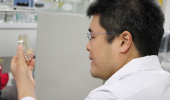領域名 食料生産学
教員氏名 川﨑 淨教
研究分野 動物栄養学

研究キーワード:アメリカミズアブ,ウサギ,ブタ,持続可能な食料生産

最近の研究課題
1. 昆虫を活用した持続可能な食料生産技術の開発
国際連合食糧農業機関(FAO)が報告書「Edible Insects」を発表して以降、昆虫を新たな食料・飼料原料と捉え昆虫生産を行う取り組みが世界的に注目を浴びています。特に、アメリカミズアブという昆虫は家畜排泄物や生ごみ等の有機性廃棄物で生育可能であり、有機廃棄物の処理後に産生される虫体を飼料原料に、残渣を肥料に用いることが可能と言われています。
我々の研究室では、持続可能な食料生産技術の開発に向けて、飼料(虫体)や肥料(残渣)の成分分析を行っています。

2. 未利用資源が家畜や食肉に与える影響解析
未だに利用されていない食品副産物や地域資源(ワイン濾過残渣やオリーブ粕等)を飼料原料として用いることで、家畜や食肉にどのような変化が起こるかを腸内細菌叢解析やメタボローム解析により調べています。

3. 養兎技術の開発・普及
食用ウサギの飼育(養兎)は世界中で行われており、日本でも秋田県・長野県を中心として養兎が行われています。ウサギの利点は、草食性のため人間の食糧とウサギの飼料が競合しにくいことや人畜共通感染症が少ないため薬剤をあまり必要としないこと、繁殖力に優れていることが挙げられることから、ウサギは持続可能な食料生産に資する畜産動物といえます。また、ウサギ肉はアレルギーを引き起こしにくいため、牛・豚肉アレルギーの方も食すことが可能です。
我々の研究室では、優れた畜産動物であるウサギの振興を目指し、養兎における日本と海外の違いや、ウサギの飼料、ウサギ肉の栄養、養兎現場で問題となっているウサギの病気などについて研究しています。


代表的な研究業績
・The Japanese white, an Akita-improved rabbit variety: Current status and problems of its farming in Japan, and possible strategies for sustenance. The 17th Asian-Australasian Association of Animal Production Societies Animal Science Congress Proceedings, 1549-1554. 2016. Kawasaki, K., Hori, A., and Yano, K.
・Dietary Mannitol Increased the Absorption of Calcium and Magnesium in Rats. Journal of Animal Physiology and Animal Nutrition 100, 715-722. 2016. Xiao, J., Sakaguchi, E., Min, X., and Kawasaki, K.
・Transfer of blood urea nitrogen to cecal microbial nitrogen is increased by fructo-oligosaccharide feeding in guinea pigs. Animal Science Journal, 86(1), 77-82, 2015. Kawasaki, K., Xiao, M., Xiao, L., Hasegawa, E., and Sakaguchi, E.
・Transfer of blood urea nitrogen to cecal microbes and nitrogen retention in mature rabbits are increased by dietary fructooligosaccharides. Animal Science Journal 85(6), 671-677, 2014.Xiao, M., Jin, X., Kawasaki, K., Xiao, L., and Sakaguchi, E.
Research Area: Food Production
Research Specialization: Animal Nutrition
Name: KAWASAKI, Kiyonori

Keywords: black soldier fly, sustainable agriculture, swine, rabbit

Recent Research
1. Development of Sustainable Food production System Using the Functions of Insects
At a Global level, the use of insect as waste bioconverters for the production of innovative products is a very hot topic. The larvae stage of the Black soldier fly, Hermetia illucens (BSF) can convert large volumes of low-grade organic substrates into valuable biomass.
We evaluate the products (FEED and FERTILIZER) obtained through the bioconversion of organic waste by BSF larvae.

2. Effect of Feeding Unused Resources on Livestock
We investigate what kind of changes will occur in livestock by using food byproducts and regional resources (such as wine filtration residues and olive lees) that have not been used yet by intestinal flora analysis or metabolome analysis

3.Development and Dissemination of Cuniculture
Rabbit production (CUNICULTURE) could be an important source of food for Japanese people, because high-protein meat can be produced from rabbits mostly fed on grass in only 70 days. Moreover, rabbit meat could become an important alternative source of protein for people with food intolerance to beef, pork and/or chicken.
In our laboratory we study differences between Japanese and overseas in the cuniculture, rabbit feed, nutrition of rabbit meat, and illness of rabbits.


Publications
・The Japanese white, an Akita-improved rabbit variety: Current status and problems of its farming in Japan, and possible strategies for sustenance. The 17th Asian-Australasian Association of Animal Production Societies Animal Science Congress Proceedings, 1549-1554. 2016. Kawasaki, K., Hori, A., and Yano, K.
・Dietary Mannitol Increased the Absorption of Calcium and Magnesium in Rats. Journal of Animal Physiology and Animal Nutrition 100, 715-722. 2016. Xiao, J., Sakaguchi, E., Min, X., and Kawasaki, K.
・Transfer of blood urea nitrogen to cecal microbial nitrogen is increased by fructo-oligosaccharide feeding in guinea pigs. Animal Science Journal, 86(1), 77-82, 2015. Kawasaki, K., Xiao, M., Xiao, L., Hasegawa, E., and Sakaguchi, E.
・Transfer of blood urea nitrogen to cecal microbes and nitrogen retention in mature rabbits are increased by dietary fructooligosaccharides. Animal Science Journal 85(6), 671-677, 2014.Xiao, M., Jin, X., Kawasaki, K., Xiao, L., and Sakaguchi, E.
このページの管理者:管理者















